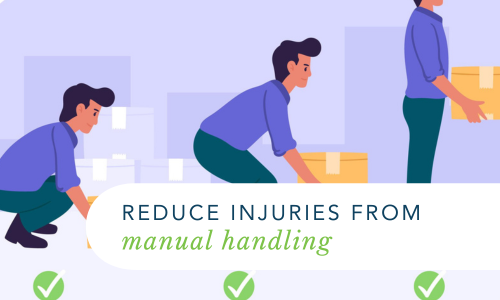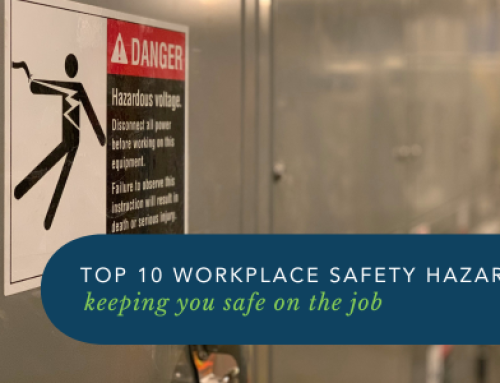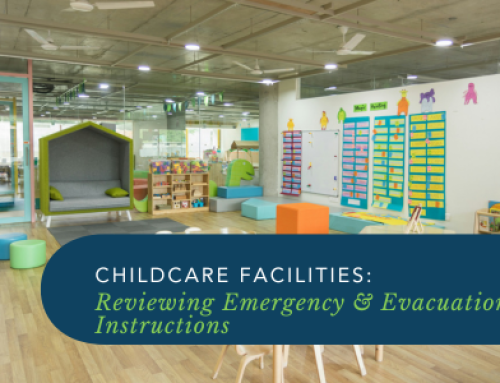All workplaces have some form of Manual Handling and this doesn’t always include the stereotypical heavy lifting that the phrase “Manual Handling” brings to mind.
Whilst Manual Handling involves pushing, carrying, lifting, etc. it also incorporates repeated actions like typing, sorting, using machinery and packing.
Even office environments lend themselves to Manual Handling risks, so it’s important to have appropriate measures in place to reduce them.
Here’s a quick guide to reducing Manual Handling injuries in your workplace, apart from the basic advice of practising proper lifting techniques and good posture.
Identify hazards in your workplace
There are risks in all workplaces that can make a Manual Handling injury more likely.
It’s important to do everything possible to identify these hazards so that they can be managed effectively.
This should include:
- Regular and thorough workplace inspections that are focused on identifying workplace hazards.
- Consulting your staff at meetings or toolbox talks about risk factors they may have identified.
- Maintaining an open dialogue with all staff members around workplace safety.
- Thoroughly investigating any workplace injuries, incidents or near misses and implement changes or control measures to ensure the risk is eliminated or mitigated.
Evaluate the risk factors you’ve found
Risk Assessment is all about determining any factors in the workplace that are adding to the risk of injury.
An example of some common factors are:
- How the workspace/workplace is laid out – staff should have ample room to safely carry out their tasks to avoid having to twist or bend into uncomfortable positions.
- How much an object weighs – if objects are too heavy or awkward for your staff to lift and carry, they are at a greater risk of injury.
Heavy objects should be marked and appropriate signage about lifting techniques and restrictions should be posted in the workplace.
- How work tasks are undertaken – if staff have to stand or sit in the same place for extended periods, it becomes detrimental to their health. Steps should be taken to ensure that they “reduce & interrupt” these extended periods by introducing short standing, sitting or stretching breaks (this will be covered further in the next section).
- Where objects are located – if staff have to lift large or heavy items from awkward positions involving a lot of bending or stretching, procedures should be put in place to minimise this requirement and training on proper lifting techniques should be available.
- Repetitive lifting and moving – if staff are required to do repetitive tasks involving repeated lifting of heavy items or repeated stretching and twisting for an extended period of time it is much different than having to do it once.
Frequent breaks should be taken and proper techniques should be trained and adhered to.
Eliminate or reduce the identified risks
Sometimes a Manual Handling hazard cannot be eliminated entirely, so it’s vital to reduce it as much as possible to lessen the potential for injury.
Here are some ways that these risks can be removed or decreased:
Adjust how a task is done
- Are there any other ways it could be completed?
- Does the task require more than one person to be completed?
- Are there any aids that could be used, such as forklifts or conveyor belts?
- Are staff being allowed adequate breaks or to change their tasks, to reduce injuries from repetition?
Adjust the item to be handled
- Can it be repacked into smaller, lighter packages instead of one big one?
Adjust workspaces
- Is there ergonomic furniture in use?
- Are benches and counters at the best height to reduce the need to stretch or bend?
Adjust the conditions in the workplace
- Can you reduce vibrations, or optimise the temperature?
Staff training is a crucial factor in reducing Manual Handling injuries
Of course, none of the above measures will make a real difference in reducing Manual Handling injuries unless your staff are trained correctly.
This training should be undertaken regularly, and you should have records in place to track staff training.
Ask yourself, is your current training adequate?
Observe your staff; are they practising proper lifting and handling techniques?
If you feel that the job of ensuring your staff are properly trained requires help from an outside source, or if you don’t have the appropriate knowledge or qualifications yourself, it might be time to talk to Workplace Emergency Management.
We provide all manner of Workplace Health and Safety training for staff in a variety of industries and environments, and present the necessary information in an engaging way to ensure knowledge retention in your team members.
We can also help you assess your workplace for Manual Handling hazards, to ensure all possible risks are identified and a plan is implemented to reduce or mitigate those risks.
Workplace Emergency Management is all about keeping your staff safe at work, no matter what their role entails.
GET IN TOUCH
Are you ready for peace of mind that your workforce is as safe and prepared as possible?
With a dedicated team of staff ready to help you meet compliance requirements and improve the overall safety of your workplace, all you need to do is get in touch.
Request your free audit today!



